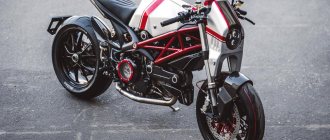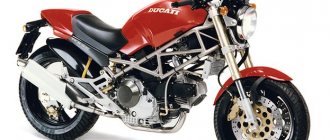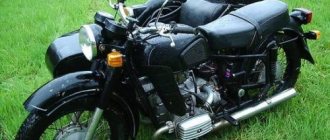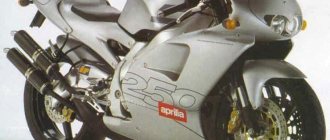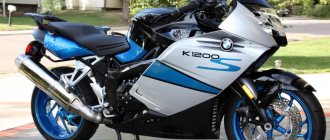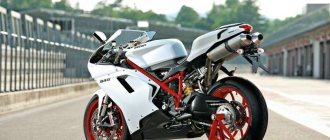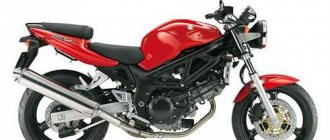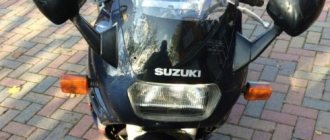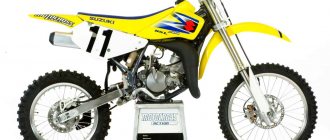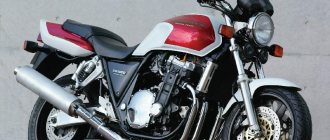Engine Ducati Monster 1100 EVO (Ducati Monster 1100)
The Desmodue Evoluzione engine was the first of Ducati's 2-valve engines to produce 100 hp. Its distinctive feature is an excellent level of power at high speeds while maintaining stable traction in all ranges, and a system with 2 valves per cylinder has significantly reduced the overall weight of the engine. In the manufacture of engine parts, innovative Vacural ® technology is used - vacuum injection molding allows us to obtain high-precision parts with an excellent safety margin.
The Ducati Monster 1100 EVO motorcycle reaches a maximum power of 100 hp. at 7500 rpm. and maximum torque of 103 Nm. at 6000.
Inevitably. This word is a reaction to the appearance of the new generation 1100 cc modification of the Ducati Monster. Ever since the "little" Monster 696 debuted a year ago, we've all been waiting for WHEN WILL IT GO BUTTER? Model Ducati Monster 1100
Model year 2009 / dry weight 169 kg / wheelbase 1450 mm / max. power 95 hp / engine 1078 cm3 / gas tank volume 15 l.
Just a few days have passed since the debut of the Ducati Monster 1100 at the Intermot motorcycle show, and I was already invited for a test drive in Southern France. Gorges and mountains, Cannes and the Riviera, all sorts of Range Rovers, Zondas and Lamborghinis on the highway - it’s hard to ask for a better environment to get to know the new musclebike from Ducati.
But the Monster brand is already 16 years old! And this monstrous family is the most profitable in the “Monster” model range. Miguel Galuzzi left for rival Aprilia, so Giulio Malagoli took up the development of the new-Monster. The 34-year-old has been working on various members of the Monster Mafia since 1999, when he joined Ducati. Since 2003, he has been the head of the team improving this series. The “1100th” differs from the “696th” both in its chassis and design. “The main task we set for the designers was that the bike should be unmistakably identified as a Monster from 200 meters,” proclaims Malagoli. The power plant - a 1098 cc air-cooled desmodromic engine - is taken from the Hypermotard 1100 model. However, with some changes.
In Italy, the Monster 1100 costs 11,200 euros, the Monster S2R, which it replaced, cost 10,000 euros. But there is also the Monster 1100S for 13,200 euros. It has a fully adjustable Ohlins front fork and the same brand of rear monoshock, which, like the Sachs shock absorber on the base version, is adjustable only by spring preload and hydraulic rebound. But it is connected to the swingarm via a linkage to create a progressive characteristic - something that the basic version does not have. The 1100S also has gold-painted wheels (however, they are the same in design as the “base” - aluminum, cast), camshaft drive belt covers made of carbon fiber, a muffler cover and a front fender. The front brake discs are mounted via aluminum brackets, which reduces unsprung weight by 0.65 kg and, thanks to a reduced gyroscopic effect, makes steering easier by 10%. In the 2009 model year, 5,000 Monster 1100s will be produced, but how many will be for the “S” version is not yet clear. “We assume that we will sell the same editions of both variants,” suggests Mario Alvisi, product manager. – This is not a final decision. Yes, the dynamics of both versions are the same, but, according to our observations, brand loyalists still love high-tech cars more, and they also love to tinker with the settings during track days. So we’ll know more precisely about the proportion of modifications going on sale when we consult with distributors.” Meanwhile, the Monster 1100S became available to users in October, and the Monster 1100 will appear in showrooms only in January of the coming year...
...We go to the embankment in Cannes to get the bikes for the test, and in front of us is only a Monster 1100 in basic configuration. Let's go!.. During the day I drove 230 km on the debutant in a variety of road conditions: on high-speed motorways and on winding mountain serpentines, in dense traffic on coastal roads and in the delightful bends of the RN7 highway... And you know what I will say? That Ducati marketers have screwed themselves up by not allowing test editors from the motorcycle media to try out the “1100S” modification as well. Because the basic version is so good that, without being able to compare, you wonder: why pay more? The front fully adjustable Showa fork (its travel is 130 mm - 10 mm more than the 696) soaks up all the potholes of rough mountain roads with commendable omnivorousness, even at a low angle of the bike. Bridgestone BT016 tires may take longer to warm up than Pirelli Diablo tires (some cars are also equipped with them), but once warmed up, they provide excellent traction. Their profile is rounder than that of Italian tires, so the device is easier to shift. In addition, the 1100 is 40 mm higher than the Monster 696, so it can be cornered deeper without fear of catching the asphalt with the running board.
The maneuverability of the motorcycle is given by a well-made steering “lever” - aluminum, with a variable cross-section, and also with adjustable brake and clutch levers. You, too, would feel the pleasant contrast of its advantages with the steel steering wheel and non-adjustable levers installed on the 696. But the seating geometry is the same: the distances between the saddle, handlebars and footpegs remain unchanged. Like the 696, the riding position is very comfortable, you feel like you're part of the bike rather than sitting on it like you do on the Monster S2R. Plus, compared to older models, you sit closer to the steering wheel. Although the “gas tank” (in quotes – because a significant part of it is occupied by the air filter) is much larger than that of previous Monsters, your knees, thanks to the profiled recesses, are just as comfortable to hug it. Another factor that creates super maneuverability is the enormous steering angle: here it is 34 degrees. This makes it easy to turn around even on narrow streets.
And in general, the handling of the new Monster is a significant step forward in comparison with everything that came before it. Due to the fact that the driver is shifted forward, the front wheel is more loaded, which adds confidence in high-speed bends. The motorcycle willingly “adjusts” when you adjust trajectories in corners, and thanks to its low weight it is very easy to shift on S-shaped ligaments.
The visibility in the mirrors is extensive, but... Keep the tool at the ready: their fastening keeps getting loose, and the mirrors tend to fold under the pressure of the incoming air.
The saddle is also of a slightly different shape than on the “696”: in the front part it is (in addition to 40 mm in height) higher by another 10 mm - to make room for the upper mount of the long Showa monoshock absorber. Which is good, especially for men: now you don’t always slide onto the gas tank like you did on the 696.” The strongly inclined monoshock absorber with a variable coil spring works so well that, again, you can’t help but wonder: is it worth paying another 2,000 euros for the “S” model with its Ohlins and carbon fiber tchotchkes? Isn’t it better to invest in a pair of Termignoni mufflers from the Ducati Performance catalog - they have both the appearance (carbon fiber bodies!) and the sound - what you need, and you also get some kind of increase in dynamics.
MONSTROUS MECHANICS
The design of both machines - the Ducati Monster 696 and Monster 1100 - began simultaneously, in the summer of 2005, but the first entered the market in the spring of 2008, the second six months later.
The space frame is made of large-diameter steel pipes - 34 mm (for comparison: on the Monster S2R model - 28 mm, and on the very first, Monster 900 - only 25 mm). The fully adjustable Showa fork is installed at the same 24 degrees as on the S2R, and the reach is the same at 87 mm, but the wheelbase has been increased to 1450 mm. The all-new cantilever swingarm weighs just 5kg and, according to Malagoli, has the best stiffness-to-weight ratio of any Ducati road swingarm. Despite the long swingarm, the bike's weight distribution over the wheels is 49/51%, but with the rider it becomes an ideal 50/50%.
The Sachs monoshock, adjustable by spring preload and hydraulic rebound, is moved to the left of the longitudinal axis to make room for the exhaust system. Although the base Monster 1100's suspension doesn't have an intermediate linkage system, progression is still provided thanks to the variable coil spring and high damper angle. “We looked at this solution from racing motorcycles of the 60s,” says Malagoli. – If the shock absorber is tilted too high, its compression is not proportional to the wheel travel. This allows us to achieve progressive performance without the burden of a linkage system.” The front 4-piston brake calipers, as well as the front brake and clutch master cylinders, are radial type. According to Malagoli, equipping the motorcycle with these very mechanisms gave a 17% increase in braking force compared to the Monster 696, which is devoid of radial delights. Cast aluminum Marchesini wheels are fitted as standard, although buyers can opt for forged ones.
The Monster 1100 weighs only 169 kg (without fluids and battery). According to Ducati experts, this is the lightest streetfighter in its category. It is also “ultra-light” due to the features of the new engine. The power unit with a displacement of 1078 cm3 (as on the Multistrada and Hypermotard) has one big advantage. When casting its parts, a vacuum filling process is used. It allows you to maintain the dimensions extremely accurately. That is why the crankcase of the Monster 1100 engine is much more compact and 3 kg lighter than that of the similar Hypermotard 1100 engine. Judge for yourself: in some areas the wall thickness has been reduced from 6 to 3 mm!
The Monster 1100 engine develops the same power - 95 hp - as the 992 cc S2R engine, but the torque is much higher: 103 Nm versus 99.1 Nm of the old power unit. The increase was obtained not only due to an increase in the working volume of the cylinders, but also due to the installation of a power valve in the exhaust system.
The 15-liter fuel tank is located exactly in the center of the car and at the rear of the visible “gas tank”. In the front part there is an air filter, and between it and the gas tank the battery, ignition coils, control unit and wires are hidden - they are no longer visible, as was the case with previous Monsters. “Dangling wires are not sexy at all,” grins Giulio Malagoli, “so we decided to hide them, the ventilation tubes, even the “extra” nuts.” The only thing that could not be hidden was the oil cooler installed above the front cylinder.
The transmission remains unchanged: a 6-speed gearbox with the same gear ratios. The dry clutch is the same, although the springs are softer and have a progressive characteristic. Service intervals have been increased to 12,000 km.
WHAT “MONSTROPAPA” SAID
Back in 1991, when Ducati still belonged to the Cagiva concern, designer Miguel Galuzzi decided to create a new type of motorcycle: he took a fresh Ducati 888 sportbike and “stripped it naked.” At first I built one copy - for myself. But when Cagiva boss Claudio Castiglioni saw what his charge was driving to work, he ordered the car to be prepared for mass production. The motorcycle debuted in 1992 at the Intermot exhibition in Cologne, and only at the very last moment Castiglioni decided to exhibit it under the Ducati brand - he initially planned to produce the Cagiva Monster.
The commercial success of the model then played a key role in the difficult task of Ducati's survival. At times, the scale of sales of Monster family cars exceeded half of all brand sales! In 1999, the Monster M600 became the leader of the Italian market - the first time in its history that Ducati achieved such significant success.
Galuzzi now heads the design center of competitor Aprilia, but he recalls with pleasure how the Monster was born: “At first I wanted to install an 888 superbike engine. But as the project approached the mass production stage, several reasons arose for choosing an air-cooled engine . Firstly, sportbikes with liquid-cooled engines were in great demand, but sales of the 900SS model with an air vent were sluggish. And there was an excess of these power units. But the most important thing is the battery. In those days, fuel injection systems, like on the 888, required a very large and powerful battery, but we did not want to spoil the clean lines of the motorcycle with its gearbox - and in the end we went with a carburetor “air vent”.
How does Galuzzi rate the new Monster? “To be honest, I’m disappointed,” replied “Monster Dad,” “it looks very heavy. I agree, you will see some great finds in it. The headlight is simply fantastic: every designer dreams of creating something traditional and at the same time so individual. But the diameter of the frame pipes is too large, and their bulk creates a feeling of heaviness of the “body”; the too massive gas tank only enhances this impression. I understand that this is because they also shoved an air filter into it. But the gas tank should be a gas tank and nothing else. And in general the motorcycle looks too pretentious. What am I comparing it to? The first Monster was the embodiment of healthy minimalism: two wheels, an engine, a gas tank, a saddle and nothing more! And the new one is heavy, whimsical, he no longer seems “undressed”. Successful details, for example, the footpeg brackets, do not save the overall picture: the motorcycle looks heavier than it actually is, and this is not good.
Understand correctly, even though I work for a competing company, Monster as a project is my idea, but do not look for the consequences of a jealous attitude in the assessments of the latest car. The market has changed: ten years ago it was possible to bolt a large engine to a lightweight chassis - and we don’t know what went down well with buyers. Now they expect individuality from a motorcycle. Where did Ducati go wrong a few years ago? I made a lot of “Monsters” with different engines, but they all looked like twins. New, I agree, with signs of uniqueness, but nothing more. He's not a rebel like the very first Monster was. And that’s already worse.”
The eye-catching digital instrument panel is the same as on the 1098R sportbike, with the only exception that its manufacturer (Digitek) has finally increased the size of the numbers on the tachometer, and it is now instantly readable. This panel has been transferred to a road bike from the world of MotoGP, but castling of this kind should be done with caution. And here’s an incident for you: there is a lap timer for 99 laps, a function for monitoring the battery condition, but there is no fuel level indicator - only a reserve light. And if it lights up when you pass the road sign “Next gas station is in 200 km”?.. A noteworthy element of the new design of the “face” is a triple headlight: in the middle there is a “dimension” strip, low beam is in its upper part, high beam is in the lower part . I rode a Monster 696 in the dark with the same headlight and I say: it shines very well.
Confidence-inspiring handling (I’m already repeating this, but the bike is worth it) and adequate brakes are their advantages to match the torquey engine of the Monster 1100. You feel the increase in traction especially sharply in comparison with the previous Monster S2R. To start the engine at low temperatures, you no longer have to manually open the damper - a special “program for cold weather” is “hardwired” into the Siemens control unit. In general, the engine runs smoothly and with much less mechanical noise than previous Ducati air vents. It is much easier to squeeze the clutch - in traffic jams your hand no longer cramps from muscle fatigue. I especially appreciated this improvement when, in a traffic jam on La Croisette in Cannes, I had to trail behind the Porsche Cayenne of Ukrainian mafiosi (I have no doubt) - a heavily tinted car with Kyiv license plates, and only bandits drive around behind impenetrable black windows in Europe.
Although the engine pulls confidently from 2000 rpm, the “happiest” range is from 4000 to 7500 rpm: a perky pickup appears and vibrations are smoothed out. So, despite the flexibility of the engine characteristics, it is better to switch the gear one step lower in order to maintain high speeds. Moreover, the gearbox is the same as on the S2R and 696 - with a very “long” top gear, which you only engage on the freeway. In the city it’s better to stay in third and drive like that without switching – the engine will pull out. And not only in the city. On one of the roads I drove uphill for 40 km, sometimes trailing along with the trailers of motor tourists, but all this time I remained on the third one. If you had to stop the motorcycle, the radial brakes worked reliably and controllably. The selection of pads is excellent.
The only thing that future owners of this excellent motorcycle with its excellent engine should take into account is that when you open the throttle fully, the engine revs very quickly. An unpleasant surprise for newcomers. For a sophisticated driver, it’s a different matter. Coming out of a “slow” turn and engaging second gear, you sharply open the gas - and the car rears up in just one moment!
Well, the developers from the Malagoli group and his team did a great job! The Ducati Monster 1100 is an achievement compared to any old “air” representative of the family... The more difficult the tasks for the future: soon the Monster S4RS with the 8-valve Testastretta engine will have to be retired. Will the future Monster 1098 be able to surpass the 1100? That's the problem...
Safety
When developing the Ducati Monster 1100 EVO motorcycle, special attention was paid to ensuring safety in all road conditions. This model is equipped with the Ducati Safe Pack, which includes ABS and the proprietary DTC traction control system, which is used in sports motorcycles that compete for Ducati in the MotoGP and Superbike series. A special feature of this system is the ability to select one of 4 levels of “trust” for the pilot. If in normal mode the system intervenes in the operation of the engine and brakes at the slightest sign of danger, then in the “professional” mode it begins to act only in the most critical situations. The presence of such a system allows the Ducati Monster 1100 EVO motorcycle (Ducati Monster 1100) to simultaneously remain “friendly” to novice drivers and leave full control over the bike for professional pilots.
- Engine and transmission Engine type 2-cylinder, 4-stroke, 90-degree V-shaped 2-cylinder
- Engine capacity 1078 cc. cm.
- Bore and stroke 98 mm × 71.5 mm
- Cooling systemAir cooling
- Power99.93 hp @ 7500 rpm
- Torque103 Nm @ 6000 rpm
- Gas driveWith cable drive
- Valves Gas distribution mechanism SOHC, with variable valve timing
- Valves per cylinder2
- Spark plugs per cylinder1
- Overall dimensions Length 2105 mm
- Curb weight189 kg
- Frame typeSteel, Trellis Frame
- SuspensionSingle shock absorber, Single wishbone
- ABS system (Anti-lock braking system) yes
Article review of the ducati monster 1100evo motorcycle
Today we will talk about the crown of evolution of all “Italian monsters” - the Ducati Monster 1100evo motorcycle. This is a limited edition in which Ducati tried to emphasize safety. What is it expressed in, you ask? The new safety package (DSP) includes ABS and a new 4-level traction control (DTC). All these new products are aimed at improving the handling of Ducati motorcycles. Both systems are cutting-edge equipment today and cannot exist without each other. They provide rider safety that previous models could not provide. Let's talk more about this highlight.
The DTC can be controlled by the switch located on the left side. The status of this system is displayed on a special display. As we said above, there are four levels that determine the degree of intervention. For example, the highest fourth, turns on the system even with a slight slip. And the first, the lowest one intervenes in control only in an emergency. This level of protection is suitable for sports driving. When DTC is ON, the display shows the selected level. The wheels are equipped with sensors that should compare the rotation speed and detect slippage. The system also offers various options for solving a particular problem. In the first stage, the DTC creates rapid ignition adjustments and gradually reduces engine speed. Also worth mentioning here is the latest APTC wet clutch. It will make the motorcycle work quietly and will serve you for many years.
This motorcycle can be classified as a factory naked motorcycle. Although in appearance it looks like a classic Japanese bike. By the way, they released the model in order to make Ducati more affordable. And this method of reducing the cost is worth attention. After all, usually, manufacturers in such cases save on components and materials. And here Ducati simply took the best that is in the line and put it all into one model. Yes, the manufacturer removed excess plastic and some miracle gadgets, but he did not sacrifice the quality of the brakes, forks or tires. At the same time, the motorcycle has not lost its signature “Dukatiev” lines, which attract the attention of all road users.
A special feature of the model is the new exhaust system, which is designed according to the 2-1-2 scheme. It increases the power of our hero several times. Also, thanks to lambda probes, gasoline is consumed very accurately.
If we talk about the chassis, then a classic steel tubular frame is installed here. It is very light and welded into a lattice design that gives away Ducati's signature style.
The engine of this motorcycle is perhaps the most outstanding in the history of the famous Italian brand. It revs higher and has a more linear torque curve. The engine is a high-power, air-cooled two-cylinder L-Twin with an advanced valve timing system, which is most often found in MotoGP bikes (we talked about it in detail in our previous article). Essentially, this motorcycle has the same problems as the Ducati Hyper Motard 1100. The only “good” difference is that the “Monster” does not have the famous dry clutch system. Perhaps this is why the model has become the best-selling model in the entire Ducati range.
The Marzocchi fork here is a 43 mm “upside-down” one, the same as on sports bikes. It is short-stroke and cannot be used anywhere except in the city. The rear swingarm system is also classic. The Sachs brand shock absorber has rebound and preload adjustment functions. That is, in essence, you can customize the suspension as you like to suit your riding style and what is called “feel” the motorcycle on the road. At the same time, the rear shock-absorbing unit is installed at a high angle, which improves the performance of the suspension and makes it easier to access its settings. And since there are no hinge mechanisms, the suspension weighs little.
The rear swingarm of the Monster 1100evo is the real highlight of the bike. He is incredibly handsome and respectable. At the same time, it is very rigid, lightweight and has improved wheel-to-road traction. This unit is made of die-cast aluminum. Actually, it is this alloy that gives the device the above listed characteristics.
The landing is classic vertical, the legs freely touch the ground, there is room for maneuvers. It's perfect for a city motorcycle.
In conclusion, it is worth saying that the Ducati Monster 1100evo is an excellent iconic motorcycle for the city. It looks great, rides and sounds even better. Stylish, powerful, practical, safe. He's not trying to be faster, taller, or stronger. Most likely, he won’t even be able to “break the Japanese buzzer,” but that’s not what this bike was created for. Such a vehicle is bought by true connoisseurs who, like an expensive Ferrari, will only drive it on weekends. The Monster 1100evo is worth owning not because of specific features, but simply because it is a Ducati - a timeless symbol of style and quality.
